
Soon it begins to affect your job, your marriage and your relationships. Like any addiction, you begin to seek out others who share your affliction and try to interest them: in my case, it was my wife who fell under the spell. Eventually it even consumed our vacations. Back when we were normal we used to camp, lie on beaches, visit friends and relatives and eat at nice restaurants. Now we drive thousands of miles to visit small towns home to nobody we know, lugging cameras, computers and documents and spend hours in basements of what seems like an endless tour of Carnegie endowed libraries, scrolling through miles of micro-films and paging through musty books. Then we drive around, trying to look inconspicuous while we stop to take pictures of houses where no relative has lived for generations, all the time hoping nobody shoots us or calls the police.
This year things were going to be different… we planned to escape the Texas heat and spend two weeks driving around Lake Michigan, relaxing and scouting possible locations for retirement (this was back when we still imagined that we might someday be able to afford to retire). We almost pulled it off too, but we finished the Michigan leg of the trip a little quicker than we anticipated and found ourselves in southern Wisconsin with a little extra time on our hands, so we decided to swing through Madison for a quick visit to the State Historical Society to see what they had to offer.
Libraries can be magical, wonderful places full of fascinating resources and helpful, knowledgeable people. Most towns have sections (some even have entire rooms) dedicated to local genealogy. I went to a town in Norway (Rakkestad) not even knowing that they had a library and ended up spending two fascinating days in the company of their full time genealogist. I was in the Rice Lake Public Library a few years ago looking for obituaries and the librarian who helped me had actually grown up next door to my grandmother. And so I entered the Wisconsin State Historical Society full of hope and optimism.
For those of you who have never visited a similar facility and who may therefore be unfamiliar with what it contains let me paint a mental picture for you: it contains books (lots of them) and microfilms (lots of those too), located in many rooms on several floors of a large building. If you are a little rusty on your Dewey Decimal system, I’ll tell you right now that there is no category for “Tony Hanson’s family”. If I had attended Hogwarts School of Witchcraft and Wizardry with Harry Potter I probably could have had the relevant films jumping out of the drawers from the dozens of metel file cabinets located in the microfilm room all by themselves. Unfortunately, I forgot to pack my magic wand.
So the problem certainly wasn’t a lack of information, or any shortcoming on the part of the staff (they were great!): I simply arrived totally unprepared for the magnitude of what was available. But I am an experienced genealogist, so I did what I usually do in such situations: panic and turn into a grouchy, grunting lump. I’m not proud of it, but it is the way I am: just ask my wife. So while I franticly looked up microfilm references, she calmly picked up on an obscure reference about the cemetery where my great great grandparents are buried and in what seemed like about 30 seconds unearthed a wealth of information about it, including the fact that it was located in Farmington, a small town about a 100 miles West of Madison.
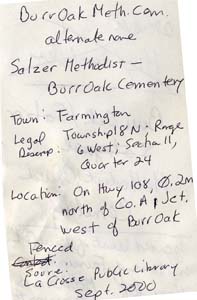
Why my gg-grandparents ended up being buried where they are has been one of those “I really need to dig into that” mysteries that all genealogists know so well. Casper Frederick Amborn came to this country with his wife (Louisa Dora Hoerining) and sons (Antone and Gottreich) in 1847 and settled in the town of Bloomfield in Walworth County. I’m almost certain that they traveled with the Kimball family, which included 2 year old Martha who would marry Antone Amborn 20 years later and (eventually) become my great grandmother.
Casper was followed in short order by brothers Henry (1850), Sebastian (1852), Anton and Daniel (1853) and John (the exact year is unknown, but he appears on the 1860 census in Bloomfield Township). With all of these connections, it was not obvious how or why he could live in Bloomfield for 24 years and end up dead and buried 200 miles away.
It turns out that Farmington was settled by German emigrants from Wernshausen, the same town in the Sachsen-Meiningen region of Germany where the Amborns and the Kimballs emmigrated from. The trip from Germany usually included a stay in Bloomfield before the last leg of the trip was completed by ox or horse, so there were strong connections between the two towns. In fact, Sebastian Amborn left Bloomfield and was living in Farmington by the time of the 1870 census. Casper was still in Walworth County in June of 1870 (according to the census) but it appears that he moved to Farmington shortly thereafter. That is probably where his daughter Bertha met and married John Storandt (a Farmington native) in 1874, and that is where Casper died in 1875. Louisa survived him for another 25 years: she died on Christmas day in 1899.
The Methodist Episcopal Church where they are both buried was formed in 1865 (one of the founding members was John Pfaff, who lived on the farm next to Sebastian in 1870). The church itself is no longer standing, and the cemetery eventually fell into neglect and was ignored and overgrown until 1966 when the graves of two Civil War soldiers buried there were re-discovered.
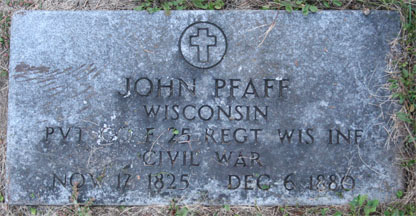
The cemetery really is out in the middle of nowhere… for the last few miles the road was hilly and had many tight curves, and my desire to beat the encroaching darkness made Kathleen nervous and nauseous (a dangerous combination in a small car at the end of a two week vacation) so I had to curb my impatience. When we finally did reach it, we could see that most of the now fenced in cemetery was without tombstones or markers of any kind. I took a few “we were there” pictures from the road, put the camera back in the car and began to walk around to examine the few remaining markers…
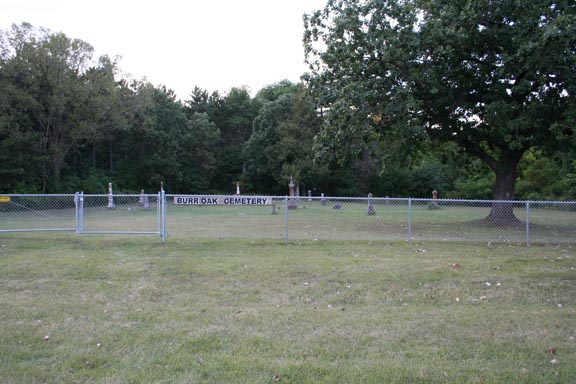
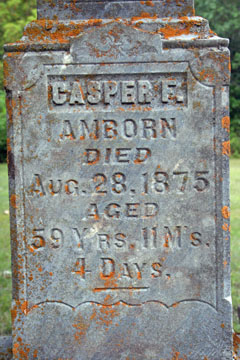
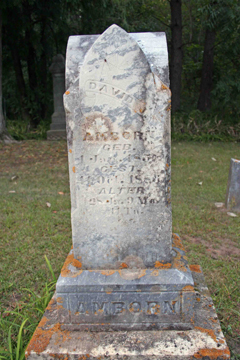
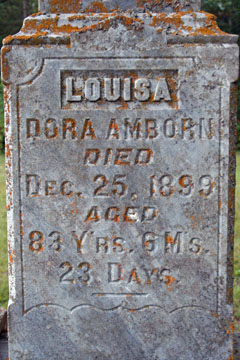
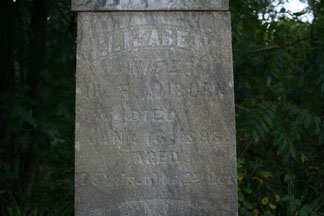
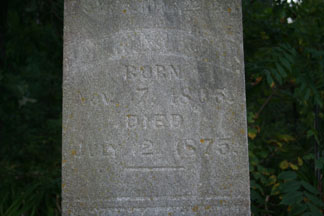
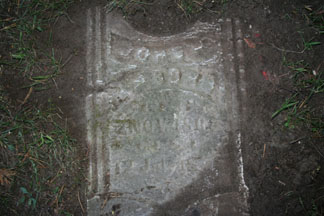
Kathleen and I are already looking forward to our next genealogical vacation.
If you would like a little more background about the Burr Oak cemeteries, I suggest you try read these articles by the La Crosse Public Library:

